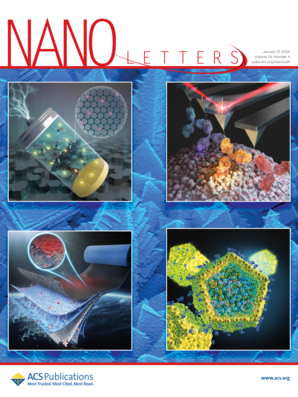Two-Dimensional Ferroelectric Altermagnets: From Model to Material Realization
IF 9.6
1区 材料科学
Q1 CHEMISTRY, MULTIDISCIPLINARY
引用次数: 0
Abstract
Multiferroic altermagnets offer new opportunities for magnetoelectric coupling and electrically tunable spintronics. However, due to intrinsic symmetry conflicts between altermagnetism and ferroelectricity, achieving their coexistence, known as ferroelectric altermagnets (FEAM), remains an outstanding challenge, especially in two-dimensional (2D) systems. Here, we propose a universal, symmetry-based design principle for 2D FEAM, supported by tight-binding models and first-principles calculations. We show that lattice distortions can break the spin equivalence and introduce the necessary rotation-related symmetry, enabling altermagnetism with electrically reversible spin splitting. Guided by this framework, we identify a family of 2D vanadium oxyhalides and sulfide halides as promising FEAM candidates. In these compounds, pseudo-Jahn–Teller distortions and Peierls-like dimerization cooperatively establish the required symmetry conditions. We further propose the magneto-optical Kerr effect as an experimental probe to confirm FEAM and its electric spin reversal. Our findings provide a practical framework for 2D FEAM and advancing electrically controlled spintronic devices.

二维铁电交替磁体:从模型到材料实现
多铁交替磁体为磁电耦合和电可调谐自旋电子学提供了新的机会。然而,由于交替磁性和铁电性之间的内在对称性冲突,实现它们的共存,称为铁电交替磁体(FEAM),仍然是一个突出的挑战,特别是在二维(2D)系统中。在这里,我们提出了一个通用的、基于对称的二维有限元分析设计原则,并以紧密结合模型和第一性原理计算为基础。我们证明晶格畸变可以打破自旋等效并引入必要的旋转相关对称性,从而实现具有电可逆自旋分裂的电磁。在这个框架的指导下,我们确定了一个二维氧化卤化钒和硫化卤化钒家族作为有前途的FEAM候选者。在这些化合物中,伪jahn - teller扭曲和类peerels二聚化共同建立了所需的对称条件。我们进一步提出磁光克尔效应作为实验探针来证实FEAM及其电自旋反转。我们的发现为二维FEAM和先进的电控自旋电子器件提供了一个实用的框架。
本文章由计算机程序翻译,如有差异,请以英文原文为准。
求助全文
约1分钟内获得全文
求助全文
来源期刊

Nano Letters
工程技术-材料科学:综合
CiteScore
16.80
自引率
2.80%
发文量
1182
审稿时长
1.4 months
期刊介绍:
Nano Letters serves as a dynamic platform for promptly disseminating original results in fundamental, applied, and emerging research across all facets of nanoscience and nanotechnology. A pivotal criterion for inclusion within Nano Letters is the convergence of at least two different areas or disciplines, ensuring a rich interdisciplinary scope. The journal is dedicated to fostering exploration in diverse areas, including:
- Experimental and theoretical findings on physical, chemical, and biological phenomena at the nanoscale
- Synthesis, characterization, and processing of organic, inorganic, polymer, and hybrid nanomaterials through physical, chemical, and biological methodologies
- Modeling and simulation of synthetic, assembly, and interaction processes
- Realization of integrated nanostructures and nano-engineered devices exhibiting advanced performance
- Applications of nanoscale materials in living and environmental systems
Nano Letters is committed to advancing and showcasing groundbreaking research that intersects various domains, fostering innovation and collaboration in the ever-evolving field of nanoscience and nanotechnology.
 求助内容:
求助内容: 应助结果提醒方式:
应助结果提醒方式:


